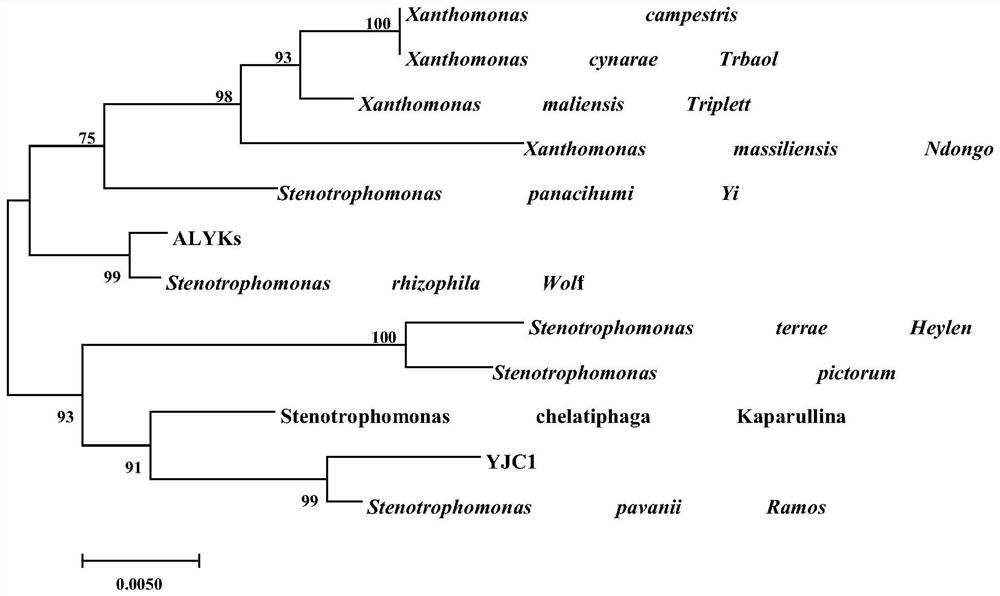A Strain of Stenotrophomonas Efficiently Degrading Polybutylene Terephthalate/Adipate and Its Application
A polybutylene terephthalate and adipate technology, applied in bacteria, hydrolase, microorganism-based methods, etc., can solve the problems of small types and numbers of microorganisms, slow degradation, and low degradation rate, and achieve excellent Degradation effect, strong adaptability, widely distributed effect
- Summary
- Abstract
- Description
- Claims
- Application Information
AI Technical Summary
Problems solved by technology
Method used
Image
Examples
Embodiment 1
[0034] The isolation and identification of embodiment 1 bacterial strain
[0035] 1. Plate separation and screening of PBAT-degrading bacteria
[0036] Collect the soil of a farmland with PBAT mulch in Yanxia Town, Liquan County, Shaanxi Province, weigh 10g of soil in a 150mL triangular flask with 90mL of sterile water, and configure 10 -1 ~10 -6 The soil bacteria suspension with a series of concentration gradients was inoculated in the inorganic salt medium with PBAT as the only carbon source. After culturing in a constant temperature incubator at 37°C for 3 days, the growth of microorganisms on the medium was observed, and a single colony was picked. Continuously inoculated several times in PBAT as the only carbon source inorganic salt medium for isolation and purification until a strain of bacteria was isolated, and then the colony morphology was observed, as shown in figure 1 As shown, the colonies were orange-red, with flat edges and smooth surfaces.
[0037] 2. Identi...
Embodiment 2
[0040] Example 2 strain producing lipase ability identification
[0041] The Stenotrophomonas was inoculated on the oil medium, cultured at 37°C for 3 days, and there were obvious red hydrolysis circles under the colonies, which showed that the bacteria could produce lipase.
Embodiment 3
[0042]Example 3 Degradation experiment of strains on PBAT membrane and lipase production experiment.
[0043] 1. Preparation of PBAT membrane
[0044] Select 5 g of PBAT film with a molecular weight of 100,000, dissolve it in 95 mL of analytically pure chloroform, stir it thoroughly until it dissolves, pour it into a mold, wait for the chloroform to volatilize, prepare a PBAT film, and cut it into 1 *1cm 2 A small piece of the strain was used for the experiment of degrading the PBAT membrane.
[0045] 2. Preparation of Medium
[0046] On the basis of PBAT as the sole carbon source inorganic salt medium, 3% butanediol and other external carbon sources were added as the co-metabolism growth substrate of the bacteria.
[0047] 3. Preparation of Seed Solution
[0048] The purified strain was inoculated in 100 mL of LB medium, and cultured for 12 hours at 37°C with a shaker speed of 130 r / min to obtain OD 600 The bacterial solution with a value of 1.0 was used as the seed solu...
PUM
 Login to View More
Login to View More Abstract
Description
Claims
Application Information
 Login to View More
Login to View More - R&D
- Intellectual Property
- Life Sciences
- Materials
- Tech Scout
- Unparalleled Data Quality
- Higher Quality Content
- 60% Fewer Hallucinations
Browse by: Latest US Patents, China's latest patents, Technical Efficacy Thesaurus, Application Domain, Technology Topic, Popular Technical Reports.
© 2025 PatSnap. All rights reserved.Legal|Privacy policy|Modern Slavery Act Transparency Statement|Sitemap|About US| Contact US: help@patsnap.com



